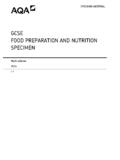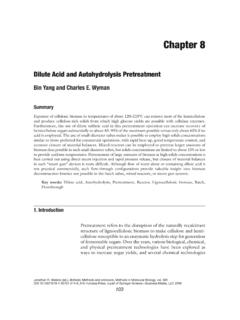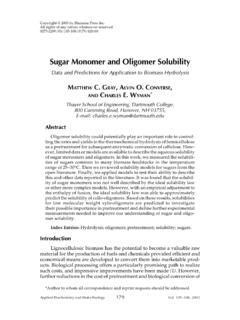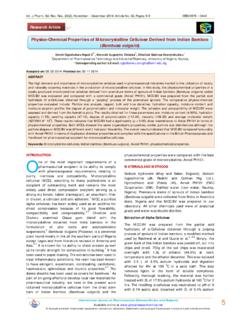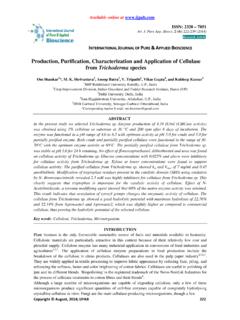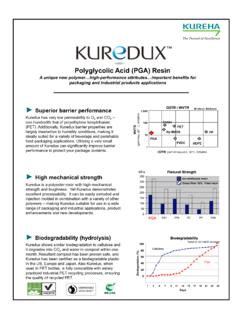Transcription of AS Biology Examiner report Paper 1 June 2016
1 AS LEVEL Biology 7401/1 report on the Examination 7401 June 2016 Version: Further copies of this report are available from Copyright 2016 AQA and its licensors. All rights reserved. AQA retains the copyright on all its publications. However, registered schools/colleges for AQA are permitted to copy material from this booklet for their own internal use, with the following important exception: AQA cannot give permission to schools/colleges to photocopy any material that is acknowledged to a third party even for internal use within the centre.
2 report ON THE EXAMINATION AS LEVEL Biology 7401/1 June 2016 3 of 7 General comments The Paper produced a range of marks from 0 to 66 and correct responses were seen in all parts of all questions. Examiners commented that many students appeared not to have prepared thoroughly for the examination. This was most evident in questions testing factual recall. Students also tended to score poorly in questions relating to new specification content and the new mathematical requirements. Performance on questions relating to practical skills was very varied but generally poorer than on similar questions in ISAs and EMPAs from the legacy specification.
3 Many examiners commented on the poor handwriting of large numbers of students. There were also many students who appeared to have used a colour of ink that produced very faint script on the online marking system. Examiners can only mark what they can read. If a student has handwriting that is perceived to be a bit difficult to read on Paper , it will be harder to read in a scanned, online form. There were a number of questions where many students failed to obey the command word, or to use information or data provided in questions, even when told to do so. It appeared that they frequently failed to read the stems of questions carefully enough, even when words were emboldened.
4 A number of questions involved (simple) logical steps that could only follow from appreciation of the content of the stems of questions. Question 1 The factual recall question, , proved far more challenging than intended. Only 5% of students obtained both marks and 54% failed to score. There was no particular pattern to the wrong answers. Question discriminated very well, with 15% obtaining three marks and 21% scoring zero. There were good, concise answers that scored three marks for including complementary base pairing and the role of DNA polymerase in joining nucleotides together to form the new DNA strand; often in two or three lines.
5 Many students failed to read the question carefully and did not answer the question as set. They wrote at length about DNA replication, starting with DNA helicase. These answers were awarded a maximum of two marks, because the question specifically asked how the complementary strand of HIV DNA is made. Many students appeared to believe that DNA actively pulls free nucleotides into place and makes them base pair; some even wrote about condensation reactions. There were students who confused transcription with replication and gave accounts of mRNA production. Some students appeared to focus on HIV and replication and gave an extended account of how HIV infects cells, uses reverse transcriptase to make DNA, incorporates its DNA into host DNA, takes over the cell, is replicated by the host cell, infects new cells and leads to AIDS.
6 They often went onto an additional page, or wrote their answer under on the next page, in breach of instructions given on the front of the exam Paper . Many of these students may have found themselves short of time for later questions. In , it was pleasing to find that many students did obey the command word to contrast and gave full statements about the differences between DNA and RNA. Many students knew enough about the structures of DNA and mRNA to give correct contrasting features and 47% obtained all three marks. report ON THE EXAMINATION AS LEVEL Biology 7401/1 June 2016 4 of 7 Question 2 About two thirds obtained the mark in for a correct description of the difference between a triglyceride and a phospholipid.
7 Those who failed to score either did not know about the structure of these molecules or just described the structure of a phospholipid (or triglyceride). In , about 40% of students could fully describe how to test for a lipid and obtained both marks. A minority described tests for other biological molecules. Many made errors in their descriptions of the emulsion test or of a positive result. These errors included: adding water before ethanol, heating the mixture, the presence of a precipitate and failing to note that the colour of the emulsion would be white. Most students scored the mark in Those who didn t got saturated and unsaturated the wrong way round in terms of carbon-carbon double bonds.
8 In , 28% obtained both marks for stating that the fat substitute would not bind to the active site of lipase because it has a different shape to a triglyceride. A similar percentage obtained one mark. Those who failed to score often ignored the question s reference to lipase and wrote about bile salts, micelles and methods of absorption. Question 3 The specification (section ) requires students to know that ATP is resynthesised by a condensation reaction involving ADP and phosphate, catalysed by ATP synthase. The examiners did not require reference to a condensation reaction but only 26% of students obtained both marks in About 40% obtained one mark for reference to ADP and phosphate.
9 Some failed to score that mark because they wrote about phosphorus. Many wasted time writing about hydrolysis of ATP but often went on to describe the reaction between ADP and phosphate. The same section of the specification ( ) requires students to know that the hydrolysis of ATP can be coupled to energy-requiring reactions, or the phoshorylation of other compounds (often making them more reactive). In , 35% of students obtained one mark for reference to ATP providing energy for a reaction (usually named). Only 3% did this and then made reference to phosphorylation to obtain the second mark.
10 In , about 40% obtained the mark by noting that the image was 3-D. Many simply wrote that the evidence was the black and white nature of the image. About 56% of students obtained both marks for the calculation in Some (about 30%) had the right idea in terms of what to divide by what but couldn t handle the units and obtained one mark. Question 4 It was pleasing to see that 73% of students obtained all three marks in It was also pleasing to see 80% correctly identify hydrogen bonds in In both and , students usually appeared to ignore the diagram in Figure 3 and the information given, despite being instructed to use both in their answers.









